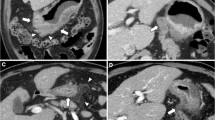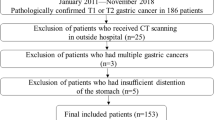Abstract
Purpose
To investigate the diagnostic performance and prognostic significance of a new criterion for radiologic T4a staging on computed tomography (CT) in patients with advanced gastric cancer (AGC).
Methods
Between January 2010 and April 2019, 101 patients with pathologically confirmed gastric cancer were collected. Among them, 53 patients with pathologic T3 and T4a cancers were included in this study. Three reviewers assessed preoperative CT scans for radiologic T staging in two sessions, independently and in consensus at a 2-week interval, while blinded about the pathologic T stage. The radiologic serosal invasion sign was defined as a nodular extension from the outer gastric wall reaching beyond the perigastric vascular plane and adopted as a new CT criterion for T4a cancer. We evaluated the diagnostic performance, interobserver agreement, and prognostic significance of this sign for the postoperative recurrence.
Results
There were 46 pathologic T3 cancers (86.7%) and seven pathologic T4a cancers (13.2%). The diagnostic performance of the radiologic serosal invasion sign in the differentiation between T3 and T4a cancers was as follows: sensitivity, 91.3%; specificity, 71.43%; and accuracy, 88.68% for R1 and sensitivity, 78.26%; specificity, 85.71%; and accuracy, 79.25% for R2. The k-value was 0.64. Among the clinical and pathologic variables, radiologic T4a sign [hazard ratio (HR): 7.96; 95% confidence interval (CI) 2.36–26.86, p = 0.001], pathologic T4a (HR 9.82, 95% CI 2.35–40.95, p = 0.002), tumor size (HR 1.18, 95% CI 1.02–1.35, p = 0.026), and lymphovascular invasion (HR 6.39, 95% CI 1.42–28.75, p = 0.015) were the significant factors for postoperative recurrence.
Conclusions
Radiologic serosal invasion sign is reliable as a new CT criterion for T4a cancer staging in patients with advanced gastric cancer, demonstrating 80% to 88% accuracy. Radiologic serosal invasion sign can also serve as a prognostic factor for postoperative recurrence as well as pathologic T4a stage.






Similar content being viewed by others
References
Bray F, Ferlay J, Soerjomataram I, Siegel RL, Torre LA, Jemal A (2018) Global cancer statistics 2018: GLOBOCAN estimates of incidence and mortality worldwide for 36 cancers in 185 countries. CA: a cancer journal for clinicians 68 (6):394-424. https://doi.org/10.3322/caac.21492
Kweon SS (2018) Updates on Cancer Epidemiology in Korea, 2018. Chonnam Med J 54 (2):90-100. https://doi.org/10.4068/cmj.2018.54.2.90
Park SR, Kim MJ, Ryu KW et al. (2010) Prognostic Value of Preoperative Clinical Staging Assessed by Computed Tomography in Resectable Gastric Cancer Patients: A Viewpoint in the Era of Preoperative Treatment. 251 (3):428-435. https://doi.org/10.1097/sla.0b013e3181ca69a7
Amin MB, Edge SB (2017) AJCC cancer staging manual. Springer,
Edge SB, Compton CC (2010) The American Joint Committee on Cancer: the 7th edition of the AJCC cancer staging manual and the future of TNM. Annals of surgical oncology 17 (6):1471-1474. https://doi.org/10.1245/s10434-010-0985-4
Seevaratnam R, Cardoso R, McGregor C et al. (2012) How useful is preoperative imaging for tumor, node, metastasis (TNM) staging of gastric cancer? A meta-analysis. Gastric cancer : official journal of the International Gastric Cancer Association and the Japanese Gastric Cancer Association 15 Suppl 1:S3-18. https://doi.org/10.1007/s10120-011-0069-6
Li MZ, Deng L, Wang JJ et al. (2014) Surgical outcomes and prognostic factors of T4 gastric cancer patients without distant metastasis. PloS one 9 (9):e107061. https://doi.org/10.1371/journal.pone.0107061
Sun Z, Xu YY, Wang ZN et al. (2011) Macroscopic serosal classification predicts peritoneal recurrence for patients with gastric cancer underwent potentially curative surgery. Annals of surgical oncology 18 (4):1068-1080. https://doi.org/10.1245/s10434-010-1449-6
Wang HH, Huang JY, Wang ZN, Sun Z, Li K, Xu HM (2016) Macroscopic Serosal Classification as a Prognostic Index in Radically Resected Stage pT3-pT4b Gastric Cancer. Annals of surgical oncology 23 (1):149-155. https://doi.org/10.1245/s10434-015-4656-3
Wang HH, Li K, Xu H, Sun Z, Wang ZN, Xu HM (2017) Improvement of T stage precision by integration of surgical and pathological staging in radically resected stage pT3-pT4b gastric cancer. Oncotarget 8 (28):46506-46513. https://doi.org/10.18632/oncotarget.14828
Kim JW, Shin SS, Heo SH et al. (2012) Diagnostic performance of 64-section CT using CT gastrography in preoperative T staging of gastric cancer according to 7th edition of AJCC cancer staging manual. European radiology 22 (3):654-662. https://doi.org/10.1007/s00330-011-2283-3
Bonnetain F, Bonsing B, Conroy T et al. (2014) Guidelines for time-to-event end-point definitions in trials for pancreatic cancer. Results of the DATECAN initiative (Definition for the Assessment of Time-to-event End-points in CANcer trials). Eur J Cancer 50 (17):2983-2993. https://doi.org/10.1016/j.ejca.2014.07.011
He P, Miao LY, Ge HY et al. (2019) Preoperative Tumor Staging of Gastric Cancer : Comparison of Double Contrast-Enhanced Ultrasound and Multidetector Computed Tomography. Journal of ultrasound in medicine: official journal of the American Institute of Ultrasound in Medicine. https://doi.org/10.1002/jum.15028
Xie ZY, Chai RM, Ding GC, Liu Y, Ren K (2018) T and N Staging of Gastric Cancer Using Dual-Source Computed Tomography. Gastroenterology research and practice 2018:5015202. https://doi.org/10.1155/2018/5015202
Lee MH, Choi D, Park MJ, Lee MW (2012) Gastric cancer: imaging and staging with MDCT based on the 7th AJCC guidelines. Abdom Imaging 37 (4):531-540. https://doi.org/10.1007/s00261-011-9780-3
Choi JI, Joo I, Lee JM (2014) State-of-the-art preoperative staging of gastric cancer by MDCT and magnetic resonance imaging. World J Gastroenterol 20 (16):4546-4557. https://doi.org/10.3748/wjg.v20.i16.4546
Kumano S, Okada M, Shimono T et al. (2012) T-staging of gastric cancer of air-filling multidetector-row CT: comparison with hydro-multidetector-row CT. Eur J Radiol 81 (11):2953-2960. https://doi.org/10.1016/j.ejrad.2011.12.039
Kupeli A, Bulut E, Cansu A, Guner A, Soyturk M, Danisan G (2019) Contribution of DECT in detecting serosal invasion of gastric cancer. Turkish journal of medical sciences 49 (3). https://doi.org/10.3906/sag-1811-168
Xing J, Chai Y, Gao J, Chen Y, Dong J, Yue S (2016) [Application of spectral CT in the differentiation of stage T3 and T4a gastric carcinoma]. Zhonghua wei chang wai ke za zhi = Chinese journal of gastrointestinal surgery 19 (5):580-584
Yang L, Shi G, Zhou T, Li Y, Li Y (2015) Quantification of the Iodine Content of Perigastric Adipose Tissue by Dual-Energy CT: A Novel Method for Preoperative Diagnosis of T4-Stage Gastric Cancer. PloS one 10 (9):e0136871. https://doi.org/10.1371/journal.pone.0136871
Yasuda K, Shiraishi N, Inomata M, Shiroshita H, Izumi K, Kitano S (2007) Prognostic significance of macroscopic serosal invasion in advanced gastric cancer. Hepato-gastroenterology 54 (79):2028-2031
Wang PL, Huang JY, Zhu Z et al. (2018) Development of a risk-scoring system to evaluate the serosal invasion for macroscopic serosal invasion positive gastric cancer patients. European journal of surgical oncology : the journal of the European Society of Surgical Oncology and the British Association of Surgical Oncology 44 (5):600-606. https://doi.org/10.1016/j.ejso.2018.01.240
Yoo C, Ryu MH, Park YS et al. (2015) Intraoperatively assessed macroscopic serosal changes in patients with curatively resected advanced gastric cancer: clinical implications for prognosis and peritoneal recurrence. Annals of surgical oncology 22 (9):2940-2947. https://doi.org/10.1245/s10434-014-4352-8
Zhao B, Mei D, Zhang J et al. (2019) The prognostic significance of macroscopic serosal change in subserosal invasion (stage T3) gastric cancer. Annals of the Royal College of Surgeons of England 101 (4):249-255. https://doi.org/10.1308/rcsann.2018.0217
Lee SL, Ku YM, Jeon HM, Lee HH (2017) Impact of the Cross-Sectional Location of Multidetector Computed Tomography Scans on Prediction of Serosal Exposure in Patients with Advanced Gastric Cancer. Annals of surgical oncology 24 (4):1003-1009. https://doi.org/10.1245/s10434-016-5670-9
Im WJ, Kim MG, Ha TK, Kwon SJ (2012) Tumor size as a prognostic factor in gastric cancer patient. Journal of gastric cancer 12 (3):164-172. https://doi.org/10.5230/jgc.2012.12.3.164
Kim JH, Lee HH, Seo HS, Jung YJ, Park CH (2018) Borrmann Type 1 Cancer is Associated with a High Recurrence Rate in Locally Advanced Gastric Cancer. Annals of surgical oncology 25 (7):2044-2052. https://doi.org/10.1245/s10434-018-6509-3
Hur H, Lee HH, Jung H, Song KY, Jeon HM, Park CH (2010) Predicting factors of unexpected peritoneal seeding in locally advanced gastric cancer: indications for staging laparoscopy. J Surg Oncol 102 (7):753-757. https://doi.org/10.1002/jso.21685
Kim DJ, Lee JH, Kim W (2014) Impact of Intraoperative Macroscopic Diagnosis of Serosal Invasion in Pathological Subserosal (pT3) Gastric Cancer. Journal of gastric cancer 14 (4):252-258. https://doi.org/10.5230/jgc.2014.14.4.252
Kang Y, Li S, Ge Q et al. (2015) Extent of Serosal Changes Predicts Peritoneal Recurrence and Poor Prognosis After Curative Surgery for Gastric Cancer. Medicine 94 (42):e1750. https://doi.org/10.1097/md.0000000000001750
Saito H, Osaki T, Murakami D et al. (2006) Macroscopic tumor size as a simple prognostic indicator in patients with gastric cancer. Am J Surg 192 (3):296-300. https://doi.org/10.1016/j.amjsurg.2006.03.004
Liu X, Xu Y, Long Z, Zhu H, Wang Y (2009) Prognostic significance of tumor size in T3 gastric cancer. Annals of surgical oncology 16 (7):1875-1882. https://doi.org/10.1245/s10434-009-0449-x
Funding
None
Author information
Authors and Affiliations
Corresponding author
Ethics declarations
Conflict of interest
All authors declare that they have no conflict of interest.
Additional information
Publisher's Note
Springer Nature remains neutral with regard to jurisdictional claims in published maps and institutional affiliations.
Electronic supplementary material
Below is the link to the electronic supplementary material.
Rights and permissions
About this article
Cite this article
You, MW., Park, S., Kang, H.J. et al. Radiologic serosal invasion sign as a new criterion of T4a gastric cancer on computed tomography: diagnostic performance and prognostic significance in patients with advanced gastric cancer. Abdom Radiol 45, 2950–2959 (2020). https://doi.org/10.1007/s00261-019-02156-3
Published:
Issue Date:
DOI: https://doi.org/10.1007/s00261-019-02156-3




